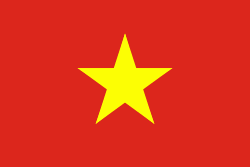Vietnamese đồng
â‚«
The dong (Vietnamese: đồng, Chữ Nôm: 銅) (sign: ₫ or informally đ in Vietnamese; code: VND) has been the currency of Vietnam since 3 May 1978. It is issued by the State Bank of Vietnam. The dong was also the currency of the predecessor states of North Vietnam and South Vietnam, having replaced the previously used French Indochinese piastre.Formerly, it was subdivided into 10 hao (hào), which were further subdivided into 10 xu, neither of which are now used due to inflation. The Vietnamese dong has increasingly moved towards exclusively using banknotes, with lower denominations printed on paper and denominations over 10,000 dong, worth about 40¢ dollar or euro, printed on polymer, as of 2022 no coins are used. Generally, Vietnam is moving towards digital payments.
As of December 2022, the Vietnamese dong was the third-lowest valued currency unit (behind the Venezuelan bolivar and Iranian rial), with one United States dollar equalling around 23,575 dong.
The word "dong" came from the material which the pennies were made (bronze). The term refers to bronze coins used in feudal China and Vietnam. The term "hao" is a loanword from the Chinese háo, meaning a tenth of a currency unit, while "xu" came from French sou. The sign is encoded.
Country
-
Vietnam
Vietnam or Viet Nam (Việt Nam, ), officially the Socialist Republic of Vietnam, is a country in Southeast Asia. It is located at the eastern edge of mainland Southeast Asia, with an area of 311699 km2 and population of 96 million, making it the world's sixteenth-most populous country. Vietnam borders China to the north, and Laos and Cambodia to the west. It shares maritime borders with Thailand through the Gulf of Thailand, and the Philippines, Indonesia, and Malaysia through the South China Sea. Its capital is Hanoi and its largest city is Ho Chi Minh City (informal popular name is Saigon).
Vietnam was inhabited by the Paleolithic age, with states established in the first millennium BC on the Red River Delta in modern-day northern Vietnam. The Han dynasty annexed Northern and Central Vietnam under Chinese rule from 111 BC, until the first dynasty emerged in 939. Successive monarchical dynasties absorbed Chinese influences through Confucianism and Buddhism, and expanded southward to the Mekong Delta, conquering Champa. The Nguyễn—the last imperial dynasty—surrendered to France in 1883. Following the August Revolution, the nationalist Viet Minh under the leadership of communist revolutionary Ho Chi Minh proclaimed independence from France in 1945.
